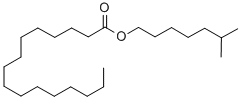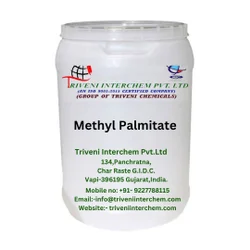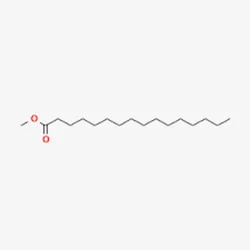Methyl palmitate
Synonym(s):n-Hexadecanoic acid methyl ester;Methyl hexadecanoate;Methyl palmitate;Palmitic acid methyl ester
- CAS NO.:112-39-0
- Empirical Formula: C17H34O2
- Molecular Weight: 270.45
- MDL number: MFCD00008994
- EINECS: 203-966-3
- SAFETY DATA SHEET (SDS)
- Update Date: 2025-12-25 11:31:46

What is Methyl palmitate?
Chemical properties
Clear colorless liquid or low melting solid. Soluble in alcohol, acetone, chloroform and benzene, soluble in ether, insoluble in water.
The Uses of Methyl palmitate
Methyl palmitate is used in the preparation of detergents, emulsifiers, wetting agents, stabilizers, resins, lubricants, plasticizers and animal feeds. It exhibits an anti-inflammatory and anti-fibrotic agent and prevents bleomycin-induced lung inflammation and fibrosis in rats. In addition, it also prevents carbon tetrachloride-induced liver fibrosis linked to reduce transforming growth factor beta, which is a secreted protein that controls proliferation, cellular differentiation and other functions in most cells.
The Uses of Methyl palmitate
Methyl palmitate can be used as an additive in food and cosmetic industries for the stabilization of fats and oil products by slowing down the auto-oxidation of unsaturated fatty acids.
What are the applications of Application
Palmitic Acid methyl ester is a saturated fatty acid ester
Definition
ChEBI: Methyl palmitate is a fatty acid methyl ester. It has a role as a metabolite.
What are the applications of Application
Methyl Palmitate is a fatty acid ester essential oil that naturally occurs in many plant species. Methyl Palmitate concentration in cells are known to be modulated by methanol. In experimental studies with isolated Kupffer cells, Methyl palmitate exhibited inhibitory activity towards phagocytosis and decreases cell viability.
Biological Functions
Saturated fatty acids are synthesized by both plants and animals from acetyl coenzyme A as a form of long- term energy storage. Palmitic acid is a common 16-carbon saturated fat that represents 10-20% of the normal human dietary fat intake, and approximately 25% of the total plasma fatty acids in plasma lipoproteins. Saturated free fatty acids induce the expression of cyclooxygenase-2. Palmitic acid methyl ester (MP) is a fatty acid ester whose concentration in cells is modulated by methanol. In studies with isolated Kupffer cells, MP inhibits phagocytosis and decreases cell viability. In cells treated with lipopolysaccharide, it also decreases secretion of interleukin-10, TNF-α, nitric oxide, and prostaglandin E2. This effect is thought to occur by the inhibition of NF-κB.
Synthesis Reference(s)
Synthetic Communications, 16, p. 1423, 1986 DOI: 10.1080/00397918608056391
General Description
Methyl palmitate (PAME), a fatty acid ester of palmitic acid, is a muscurinic receptors antagonist. Methyl palmitate functions as a vasodilator and relaxes the arterioles in retina upon electrical depolarization. In the superior cervical ganglion, methyl palmitate modulates nicotinic receptor. Endogenous methyl palmitate modulates nicotinic receptor-mediated transmission in the superior cervical ganglion. PAME activates Kv7 channels and promotes perivascular adipose tissue.
Flammability and Explosibility
Non flammable
Biochem/physiol Actions
Methyl palmitate has anti-inflammatory and anti-fibrotic effect. Methyl palmitate prevents bleomycin-induced lung inflammation and fibrosis in rats, by inhibiting NF-κB . Methyl palmitate also prevents CCl4-induced liver fibrosis linked to reduced TGF-β .
Properties of Methyl palmitate
| Melting point: | 32-35 °C (lit.) |
| Boiling point: | 185 °C/10 mmHg (lit.) |
| Density | 0.852 g/mL at 25 °C (lit.) |
| vapor pressure | 0.008Pa at 25℃ |
| refractive index | n |
| Flash point: | >230 °F |
| storage temp. | 2-8°C |
| solubility | Chloroform (Sparingly), Methanol (Slightly) |
| form | Liquid or Low Melting Solid |
| color | Clear colorless |
| Specific Gravity | 0.852 |
| Odor | at 100.00 %. oily waxy fatty orris |
| Water Solubility | INSOLUBLE |
| BRN | 1780973 |
| CAS DataBase Reference | 112-39-0(CAS DataBase Reference) |
| NIST Chemistry Reference | Hexadecanoic acid, methyl ester(112-39-0) |
| EPA Substance Registry System | Methyl palmitate (112-39-0) |
Safety information for Methyl palmitate
Computed Descriptors for Methyl palmitate
Methyl palmitate manufacturer
Triveni Interchem Private Limited (Group Of Triveni Chemicals)
New Products
Indole Methyl Resin tert-butyl 9-methoxy-3-azaspiro[5.5]undecane-3-carboxylate Boc-His(Boc)-OH 2-CTC Resin 4-Chloro-7-tosy1-7Hpyrrolo[2,3-d]pyrimidine 5,7-Dibromo-1H-indole 2,5-dichloro-N-hydroxy-4,6-dimethylpyridine-3-carboximidamide 2,2-Dimethoxy-7-azaspiro[3.5]nonane hydrochloride 4-chloromethyl-5-methyl-1,3-dioxol-2-one (DMDO-Cl) R-2-BENZYLOXY PROPIONIC ACID 1,1’-CARBONYLDIIMIDAZOLE 1,1’-CARBONYLDI (1,2-4 TRIAZOLE) N-METHYL INDAZOLE-3-CARBOXYLIC ACID 4-((2-hydroxyethyl)thio)benzoic acid 1-(TERT-BUTOXYCARBONYL)-2-PYRROLIDINONE Methyl 6-methylnicotinate 3-Pyridineacrylic acid tert-Butyl carbazate TETRAHYDRO-2H-PYRAN-3-OL 2-((4-morpholinophenylamino) (methylthio) methylene) malononitrile 3-(4-morpholinophenylamino)-5-amino-1H-pyrazole-4-carbonitrile 2,4-dihydroxybenzaldehyde 1,3-Diethyl-1,3-Diphenylurea Methyl 2-methylquinoline-6-carboxylateRelated products of tetrahydrofuran








You may like
-
 Methyl palmitate 98%View Details
Methyl palmitate 98%View Details -
 Methyl palmitate 99%View Details
Methyl palmitate 99%View Details -
 Methyl palmitate CAS 112-39-0View Details
Methyl palmitate CAS 112-39-0View Details
112-39-0 -
 Palmitic Acid Methyl Ester Reference Standard CAS 112-39-0View Details
Palmitic Acid Methyl Ester Reference Standard CAS 112-39-0View Details
112-39-0 -
 Methyl Palmitate, For PharmaView Details
Methyl Palmitate, For PharmaView Details
112-39-0 -
 Methyl Palmitate, 98%, Packaging Size: DrumView Details
Methyl Palmitate, 98%, Packaging Size: DrumView Details
112-39-0 -
 Methyl PalmitateView Details
Methyl PalmitateView Details
112-39-0 -
 Methyl PalmitateView Details
Methyl PalmitateView Details
112-39-0
